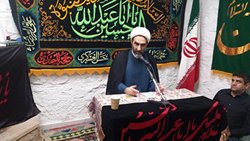 Hujjat al-Islam Moballeghi said, “The benefit of social interpretation of Ashura activism is to take a scientific view of the uprising of Imam al-Husayn.”
Hujjat al-Islam Moballeghi said, “The benefit of social interpretation of Ashura activism is to take a scientific view of the uprising of Imam al-Husayn.” RNA – Speaking to a group of Iranians in Greece at the Consulate of the Islamic Republic of Iran in Greece on the occasion of the first ten days of Muharram, Hujjat al-Islam Ahmad Moballeghi said, “This view can explain many of the invisible angles of this movement for the generations of today who carry new perspectives and possesses new needs.”
The head of the Islamic Research Centre of the Islamic Consultative Assembly referred to the centrality of the “element of consciousness” in the formation of activism and said, “Activism arising from awareness on the day of Ashura can be divided into three parts: the very conscious focus of the Imam on his position, the conscious focus on the position of the opposite side and the conscious focus on the emerging positions on day of Ashura.”
He said that Imam al-Husayn’s conscious activism arises from his status and said, “On the day of Ashura, Imam al-Husayn focused on his two statuses – namely his religious and attributed statuses.”
Hujjat al-Islam Moballeghi said, “On the day of Ashura, Imam al-Husayn focused strongly on two positions – being a Master of the Youth for Paradise and being a (grand)son of the Messenger of God – and carried out his divine activism by focusing on his statuses (which was understood for the people gathered).”
Noting some of the key objectives were behind this active activism on Ashura, the member of the Assembly of Experts said, “These objectives include explaining the deep philosophy of the ‘act of accepting humiliation’ (which formed the basis of the uprising) and inciting human and Islamic consciences through paying attention to the depth of the ongoing tragedy, protecting the Ahl al-Bayt as the red line of the Messenger of Islam and religion and ‘building an Islamic society on the basis of correct status,’ and not the distortion of statuses.”
He said that according to the Holy Quran, the Prophet Muhammad’s red line was his Ahl al-Bayt and added, “Imam al-Husayn witnessed the breaking of this red line and that led to him being murdered.”
Hujjat al-Islam Moballeghi stated, “Therefore, Imam al-Husayn focused on emphasizing this red line and institution in order to prevent its continuation in history. If this trend continued, the Prophet’s red line would have been broken forever and the name and memory of the Prophet of Islam itself would be minimized after some time.”
He noted, “The problem that existed that during that era was that on the one hand, false statues were formed, and on the other hand, the system of human expectations of these statuses was diminished. By focusing on his social-religious status and the negating the false statuses of Ubaydullah ibn Ziyad [the Umayyad governor of Basrah, Kufah and Khorasan] and Yazid ibn Mu’awiyah [the caliph of the Umayyad caliphate], Imam al-Husayn sought to establish society on three paths – to correct and strengthen correct attention to the statuses and to present the framework of this attention, to strengthen the activities from the origin of these status and to correct the system of the expectations of these statuses.”
Rasa News Agency
112/973